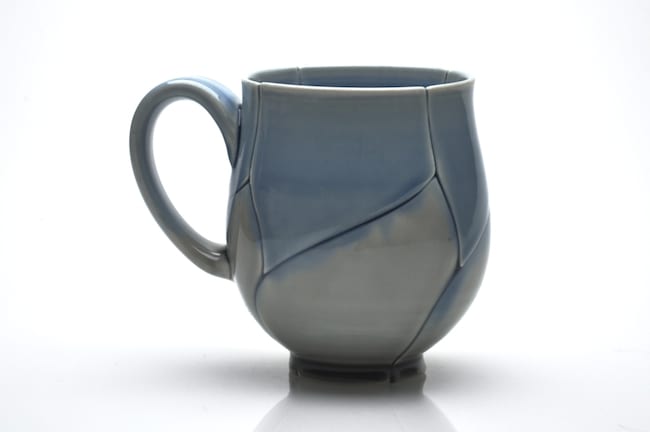The following is an excerpt from a piece written by sculptor Christina A. West regarding ceramic artist Jeff Campana’s reconstructed vessels.
Jeff Campana makes functional pots with elegant yet sturdy forms that sit in their environments with a quiet dignity. Their soft, sensual curves and soothing colors draw people to them. And it’s through close contact that the extraordinary nature of these pots is revealed as details begin to tell the story of their unorthodox creation—a process that is essential to the aesthetic and conceptual richness of the work.
The surfaces of Campana’s pots are minimally decorated, with the most prominent element being organic, flowing lines that visually break the form into smaller sections. These lines are placed in acute response to the form, pulling the eye over volumes in a way that accentuates their curves and, often, parallels the movement of liquid through the vessel. On such example is Campana’s teapot form that displays a prominent line running from the lower part of the pot near the handle, moving with a gentle curve across the form until it bisects the spout, mirroring the flow of tea as it is poured from the vessel.

From a distance, or from certain images, these lines appear to be deeply incised in the clay. But in personal contact with the pieces it becomes obvious that those lines continue through the clay walls, appearing on the interiors of the pots as well, revealing that those decorative lines are more than surface treatment. Those lines are seams—the juncture of once separate pieces of clay. Picture here Campana carefully stacking thin clay pieces like a three-dimensional puzzle held together with slip. The way the vessel arrives at the stage where it is essentially a pile of pieces takes more moxie than many craftsmen care to conjure because it first involves the complete deconstruction of a perfectly good pot. After throwing his forms, Campana approaches the pots with a knife, wielding the tool with the precision and confidence of a surgeon as he slices into the clay. He cuts the form into pieces that often look like stylized plant leafs and flower petals, extracting pieces from the volume until it resembles a pile of plucked petals more than a container. Then he does something almost Zen-like in its conceptual simplicity—Campana takes the pile of clay pieces and puts them back together in the same configuration from which they just came. He reconstructs the vessel to its original form, leaving the seams as evidence of its recent fragmentation.

People can, indeed, use Campana’s pots because impeccable craftsmanship, rigorous quality control, and applied knowledge about clay and glaze chemistry ensure that each pot that goes out into the world is just as strong, if not stronger, than a pot that hasn’t undergone reconstruction. As telling evidence of this, when Campana breaks a pot with a hammer (a quality control measure) the form never breaks at one of the seams as would be expected. This illustration lends itself to the obvious connection with the strength of seams sewn into fabric, but since pottery partakes so readily in references to the human body—mention of a lip, foot, or neck could just as easily be part of a description of a pot as an excerpt from the Hokey Pokey—it’s natural to draw out more bodily analogies. Campana clearly sees a connection to the body in his work, writing in his artist statement that each seam on his pots is “a scar where it was once severed.” Just as a scar forms where the skin once was damaged and then heals over with densely aligned collagen proteins, glaze pools on his pots at the points where they once were broken, sealing the juncture with a strong, glassy surface.
The seams of Campana’s pots point to the story of their creation, similar to the way the landmarks like scars and wrinkles on human bodies can suggest something about personal histories. Those sealed cuts affect our perception of the pots, potentially prompting one to question their functionality on an initial encounter, but a soon thereafter prompting a rich experience of both use and contemplation.
Christina A. West is a sculptor, writer and artist.
Any thoughts about this post? Share yours in the comment box below.


“Reconstructed” vessels by Jeff Campana.

Add your valued opinion to this post.